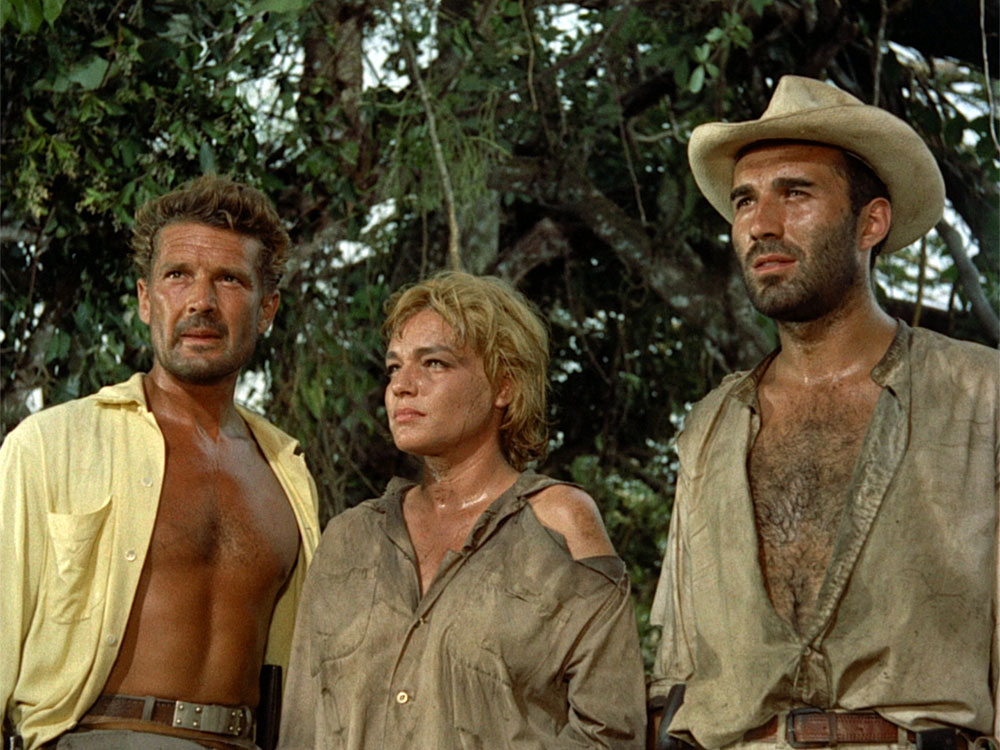By the time Buñuel directed Death in the Garden (1956) he had already managed 15 productions since moving to Mexico, proving himself both a capable commercial director and a beloved filmmaker among the critics at Cahiers du Cinema. Still a little under a decade away from returning to European productions full time, the film sits squarely in the middle of his filmography and represents a fascinating crossroads in his career, demonstrating his command of the Mexican studio system while hinting toward his later return to the freewheeling surrealism that initially catapulted him into notoriety. A French-Mexican co-production, Death in the Garden proved middling in its financial and critical reception, deemed as a failure by Buñuel. Despite this, the film still demonstrates themes Buñuel would perfect in his later work, namely the reemergence of humanities’ subconscious desires and self-destructive tendencies when removed from the constraints of social order.
Set in a fictional South American country, the first half of the film focuses on a local diamond miners’ uprising that is spurred by the military government’s revocation of their mining privileges and confiscation of their equipment. Amidst the revolutionary fervor, we meet our main characters: Georges Marcel as a less than charming rogue, Simone Signoret as an opportunistic prostitute, Charels Vinnel as a pacifist miner, Michele Girardon as the miner’s innocent deaf mute daughter, and Michael Piccoli as a naive local priest (perhaps the most genuinely moral priest Buñuel put to screen with exception to Father Nazario). Despite their best efforts, they each get caught up in the military crackdown that follows the uprising and are forced to flee into the jungle.
Buñuel directs the first section with a sure hand, using the action adventure template to get some digs in at his favorite topics of critique: organized religion and authoritarian military regimes. It’s all competently orchestrated, and though lacking in much of his signature stylistic flair, he sets up the conflicting individual natures of his five protagonists quite effectively. It’s the second half of the film where Buñuel’s signature surrealist touches are fully indulged. Amidst the character’s desperate fight for survival in the jungle we are treated to a series of striking images: Girardon’s hair tangled in the branches of a tree, a boa constrictor being devoured by a sea of ants, and a sudden return to modern society that’s immediately cast aside as an illusion.
As in the best of Buñuel’s work, civilizations' luxuries and conventions are revealed to be a thin veneer masking people’s subconscious urges and violent animal behavior. Stripped of the societal skeleton that upholds their existence and left to the whims of an immaterial world, his protagonists fall back on their basic instincts and turn on each other as chaos reigns. Buñuel subverts the essence of the action adventure genre, in which adventurers typically overcome nature’s obstacles and return to civilization with a newfound perspective on life, by only allowing characters cunning enough to grab a gun or stay out of the crossfire to survive. Bloodied and with all hope of social cohesion eradicated, their wish to escape the oppression of their old world is dashed by their inability to move beyond the ideologies it has internalized in them.
Buñuel was an ambivalent pessimist, eager to upset but always sincere and looking to illuminate viewers with his provocations. His ambivalence toward his characters’ fates conveys a deep understanding of humanity's cyclical tendencies toward upheaval and subsequent temporary stability. The miners do not successfully overthrow the military because they lack the resources to do so and the adventurers are not able to escape the jungle because their horniness, greed, and fear of god prevents them from doing so. Instead, they simply wander, shiver, and pray. Left to suffocate in cosmic predicaments beyond their control, immediate hedonistic fulfillment becomes their only respite as they journey through the wilderness hoping to stumble upon an unreachable eden.
Death in the Garden screens tomorrow afternoon, February 11, and on February 20, at the Museum of Modern Art as part of “Buñuel in Mexico.”



